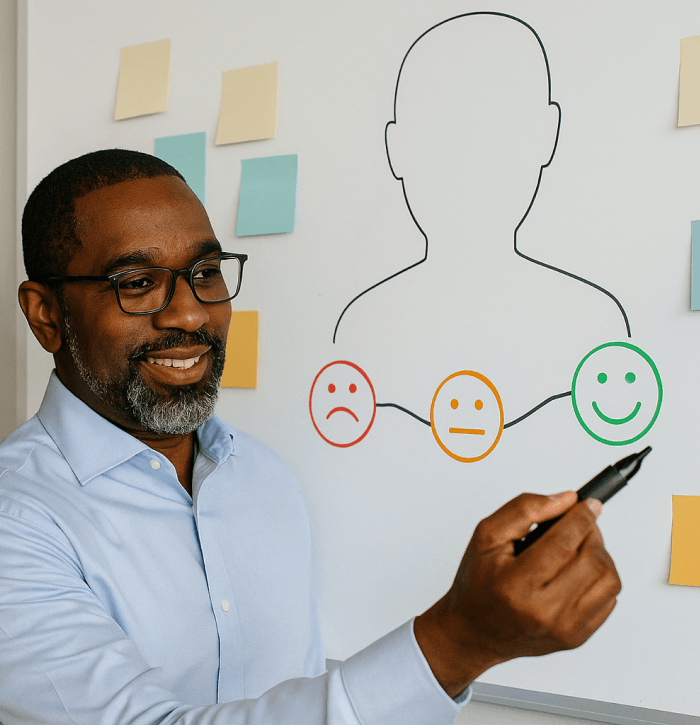Updated: January 24, 2024- 8 min read
We’ve made it through Q1 of 2021. As an industry, tech has had time to reflect on what we all learned from 2020, to let the dust settle, and to start feeling more comfortable with the new normal. All aspects of product development have felt the effects of last year, and of course, product design is no exception.
In the spirit of wearing many hats, today we’re going to dive into some of the more formative trends in product design for the rest of the year that product managers need to be aware of.
Inclusive Design
In 2021, we’re seeing more roles within design focused on achieving equitable outcomes. Rather than asking all designers to be educated and focused on making their every design choice inclusive (though it’s certainly something they should be encouraged to keep in mind), many companies are hiring new roles within their designs teams. Companies have had Diversity and Inclusion (D&I Roles) for a while now, so that’s nothing new. But companies that have already embraced design thinking have also begun hiring design professionals whose primary function is to ensure that the overall design of a product is inclusive.
That’s because D&I is about more than making sure every small design decision has more than one type of person in mind. It’s about making sure that everyone in the company understands the definition of D&I, and what the company as a whole is doing to work towards building equitable products. D&I goals are the same as any other business goals – there needs to be cohesion and alignment from the ground up.
As well as formal roles being created, existing designers will be taking more of a role in assisting a company’s D&I goals. Jacob Hernandez, Product Designer at LinkedIn, says that one of his main responsibilities as a designer is “analysing biases”, and that he expects designers to “start stepping into the responsibility that [they] have.”
As the world moves more and more online, thanks to 2020, companies are poised to take advantage of more markets. But one design can’t work for all markets, so development and design teams will be expected to find alternative solutions. Building with empathy means researching new markets from a user-focused perspective. What unique problems do these new potential users face that your product needs to solve? For example, as Uber grew the product teams realized that not every market has easy access to credit cards, so they introduced cash payments.
You might also be interested in: What Is Inclusive Digital Product Design?
Generalists Over Specialists
Something that’s been true for product managers is now overlapping into the design side, where professionals with a ‘T-shape’ skill set are becoming more and more valuable. Experts estimate that we’ll be seeing more overlap between roles, as jobs become more flexible and individuals are expected to have a wider range of skills under their belt.
This doesn’t mean that formal roles will dissolve and everyone will do everything. What it means is that designers will be expected to have more experience in more aspects of design, instead of having a deep but narrow understanding of only one area.
This will be particularly helpful to small teams as they try to navigate a constantly shifting market (let’s face it, every market in 2020/21 is ever shifting!). Having all of your bases covered by more than one individual, albeit at different skill levels, will be vital in ensuring that a team remains flexible and able to respond quickly to change.
For companies of all sizes, having teams powered by generalists is a great boost to communication. It allows teams to really collaborate, and talk with eachother rather than at eachother. Imagine if, in daily standup meetings, teams understood what eachother were up to, rather than hearing a list of tasks rattled off as they daydream about what they’re having for lunch. Better understanding leads to better collaboration, and more cohesive product design.
Check out: Design Tools For Product Managers
Business Thinking in Design, Design Thinking in Business
As a product manager, a key aspect of your role is to help different disciplines communicate with each other, by speaking their languages. You help translate business needs to engineers, and help to translate design problems into business-speak for c-suite.
One thing that design experts expect to see this year is that designers will have to start implementing business thinking when communicating outside of their teams. Not only will this help when communicating with c-suite, but it’ll help the business goals be more embedded into design’s goals. Using business metrics to validate design decisions helps align the designers on business goals, but it also helps them to communicate more effectively with non-designers, which increases empathy and understanding between cross-functional teams.
Design thinking in business is not that new. To compliment that in 2021, we can expect to see more business thinking in design. This helps businesses to design better products and for designers to step into their responsibility as champions of their organizations business goals.
A Move Away from ‘Blands’ for New Businesses
So let’s talk visuals, which you don’t need to be a fine artist to understand. Some product managers may be the Dali of UI and branding, but others may not. Either way, understanding why your designers are making the aesthetic choices that they are will be an asset to your conversations with them.
As far back as 2019 (yes, two years is far back in the tech industry!), consumers began to notice the overwhelming trend of simple branding and product design. Almost every influential company on earth flattened their logos, fashion brands suddenly all switched to the same Sans-Serif-esque fonts, and our phones were awash with apps that favored either black/white/grey or pale pastel palettes.
Companies became mission-driven, using their core values and ethics to sell themselves, whilst blending in with the relatively harmless product design that they shared with every other product like them. If you squint, it’s hard to tell which is a luxury shopping app and which is a ride sharing app.
While minimalism isn’t going anywhere, new businesses will be finding ways for their branding to stand out against this trend of ‘blands’. Nature imagery and earth tones are being pegged by many design leaders as the upcoming aesthetic trends. Of course, that won’t work for every brand, but in a world where branding and content are kings, things as simple as logo font and homepage design will be instrumental in attracting new users and (more importantly) retaining them.
More Collaboration
The final trend that we expect to see more of in 2021 is collaboration.
“More collaboration? More?! How can we possibly be collaborating more than we already are?!” you might find yourself saying. If that’s you, you’re either working more in isolation that you realize, or you’re one of the lucky ones who already work in a collaboration-driven environment.
Companies that have been slow to adopt agile practices will have to start implementing a strong approach to collaboration. More collaboration as a trend is a culmination of the other trends we’re expecting to see throughout the rest of the year.
For companies who have begun to foster a collaborative product development environment, it’s time to start thinking about collaboration in terms of quality and not quantity. Collaboration is often measured by ‘how much we talk to each other’ rather than ‘how we talk to each other’. In a world of remote working and Zoom fatigue, that’s just not going to work anymore. Organic watercooler moments are difficult to manufacture, so companies need to cut down on the formal meetings that actually no longer serve, and try to provide more room for brainstorming and creative thinking.
If you find yourself in meetings where a lot of words are spoken without anything really being said, it’s time to rethink your approach to collaboration. What worked before when you could lean over and talk to the person next to you might have stopped working when everything went remote. If you didn’t take the right steps to correct that, it’s long overdue in Q2 of 2021.
Learn More About Design
Unless you’ve come from a design background, as a product manager you could probably do with a bit more education on the subject. So start off by checking out these awesome talks:
A User Guide to Product Design by Google’s Director of UX
How to Design UX for AI by Zillow Principal PM
Design for Value with Adobe’s Senior Product Manager
Updated: January 24, 2024





